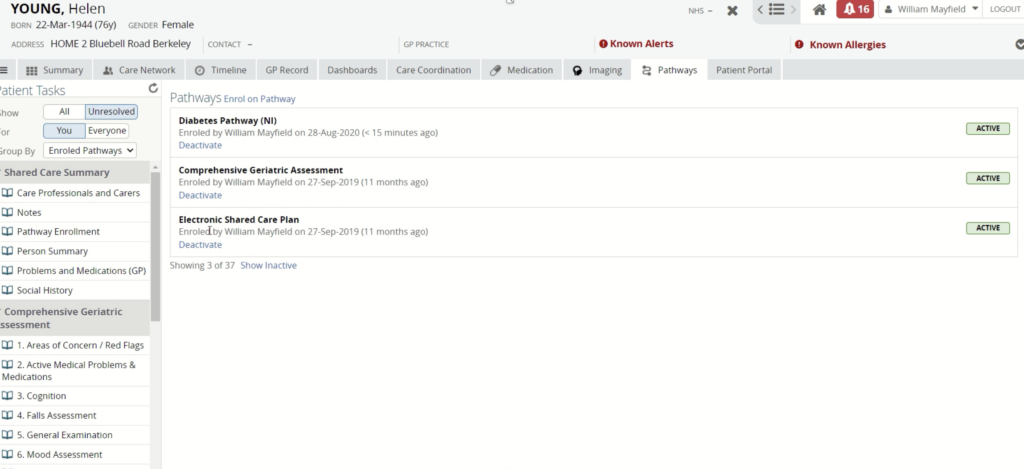Healthcare organisations around the world are looking to change the way they work, and to move from a model of care that is focused on institutions to one that delivers integrated care wrapped around the person.
In order to achieve this, information is required. That said, ensuring that all the professionals involved in a person’s care have access to the data and tools they need is a challenge.
As Pauline McLean, clinical consultant at Orion Health, told the second of its autumn customer webinars: “What we all acknowledge is that having the right information in the hands of everyone involved in a person’s health and wellbeing results in better outcomes for individuals.
“We can avoid delays in diagnosis, reduce the number of repeated tests, and co-ordinate care for individuals across multiple health and social care organisations by sharing data that is known to be important. Just as importantly, we can help people to be active participants in their own decision making.
“However, achieving all this takes time. It takes leadership, strong governance, good infrastructure, and good architecture to lay the foundations for the digital solutions that we build on top, so they can deliver the expected operational and clinical benefits.”
Care Pathways and Collaborative Worklists
Once those foundations are in place, Orion Health has a suite of tools to support the creation and management of Care Pathways. Orion Health Coordinate is built out from the Amadeus health data platform and so integrates with other Orion Health products, such as the Engage patient portal, Medicines Platform and the Discover analytics suite.
Product specialist Bruce Horne took the webinar through Coordinate’s Care Pathways and demonstrated how a pathway is “a group of tasks and assessments, built… to drive more consistent patient workflows and, therefore, to promote best practice.”

Tasks and assessments can be configured according to a workflow to promote consistent ways of working. For example, if one professional registers a patient on a pathway, another may be alerted to complete an assessment.
Forms functionality can be used to create electronic documents that pull information from other records in the clinical portal and capture information in a consistent format. This reduces duplication of effort and, with Pathways summary views, makes it simple for a new team member to assess a patient’s history at a glance. Capturing of structured data in forms also enriches further reporting and analysis.
Meanwhile, Progress Notes, also built from the Care Pathways product, allows a professional to create a free text note related to a person. This information can be accessible to other team members, as long as they have the appropriate role. Access to specific notes can be made subject to consent and sensitivity restrictions placed on the person’s record where appropriate.
Horne also demonstrated Collaborative Worklists, which allows professionals to create patient lists, drag and drop in the data items they need to manage them effectively, and share them with others involved in the patient’s care with suitable permissions. Both Collaborative Worklists and Care Pathways are well suited to support multidisciplinary working through the shared care record.
New care models in action
So how are these products being used? Orion Health has 40 customers for Care Pathways and 28 for Collaborative Worklists. In the UK, they include the Northern Ireland Electronic Care Record, which has used Care Pathways to create a national diabetes pathway and is about to roll-out others, and the Dorset Care Record, which has a maternity pathway live and is also now focusing on diabetes.
Orion Health is also using Care Pathways to develop an out-of-the-box “ReSPECT” solution in the UK, supporting the “Recommended Summary Plan for Emergency Care and Treatment” that has been developed nationally in collaboration with clinicians and patients. This solution will enable a health professional to electronically record recommendations for clinical care in a future emergency situation where the patient does not have the capacity to make or express choices, based on a conversation with them, and to make this available within the shared care record. For example, these recommendations include whether or not CPR should be attempted.
Internationally, Orion Health customers using Coordinate solutions include the Canterbury District Health Board (DHB) in New Zealand, which has used Care Pathways to record an Advanced Care Plan (ACP) for 1,600 residents of the city. Product director Vianney Chauvineau explained that 70-100 ACPs are being created each month, mostly in primary care.
“The GP creates a care plan with the patient and makes it available across the healthcare community,” he said. “If the patient has to go to hospital, then it is very easy for the hospital staff to see that there is a care plan available. Then, they can read the information it contains, to help them manage the patient effectively and act on their wishes.”
GPs in the Canterbury DHB area have seen a 27% increase in the number of ACPs accessed by hospital staff since they went digital. Another New Zealand customer is the National Child Health Information Platform, which was set up to monitor the progress of children from 0-16.
The platform aggregates data from many systems and uses Care Pathways to check that the 130,000 children it covers are hitting key milestones. Due and overdue task reports enable services to pick up children who might otherwise fall through gaps.

As an example, Vianney Chauvineau said the Midlands Region had picked up 6,000 children who were previously unknown to its community oral health service; helping it to prevent tooth decay, which is a particular issue for Maori and Pacific children.
Great tools need great builders
Orion Health launched Coordinate back in 2010, but has worked on the product ever since. Indeed, the company is currently releasing upgrades and new functionality every few months.
Product specialist lead Ben Wilson indicated that plans for the near future include patient forms, to enable patients to contribute information to integrated care teams, and mobility to enable those teams to carry out defined tasks quickly and easily.
However, in response to a question from the webinar audience, Pauline McLean looped back to her starting point and stressed that while tools like Coordinate can support new ways of working, they cannot create them. Change has to start at the top, she said, with leadership “at the highest level”, a clear business case, strong reporting lines into working groups, and good communication.
“The organisation needs to know what is coming and why,” she said. “End users have to be really interested and understand: ‘what is going to be important to me, what difference is it going to make to my daily job, and what benefits will it give me in the way that I manage and care for my patients?’”
The Orion Health customers that have made the most effective use of Coordinate have cracked these issues, she said; often by starting with a plan, but breaking it down into bite-sized chunks to build engagement and momentum.
The Northern Ireland diabetes pathway, for example, started with one clinician wanting to capture some information in the Northern Ireland Electronic Care Record. Others saw it, wanted to share it, came up with their own ideas, and went from there. So, to deliver on the promise of integrated, wrap-around care, good tools are essential. But in the end, “it is all down to the people in the mix.”



